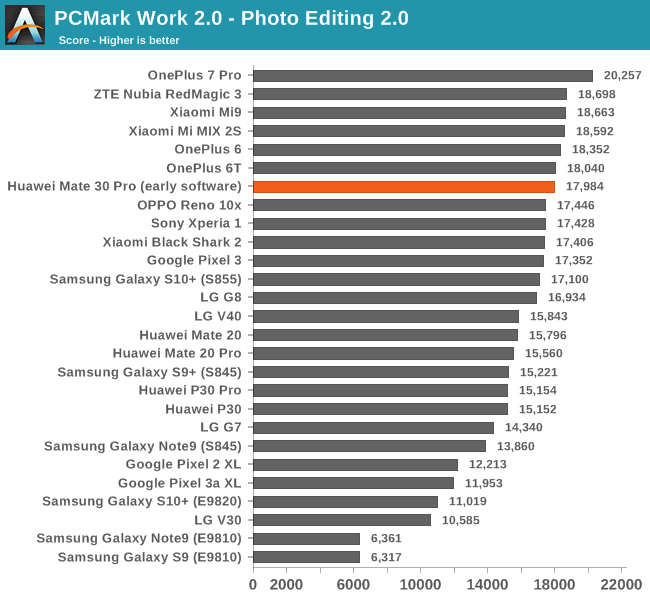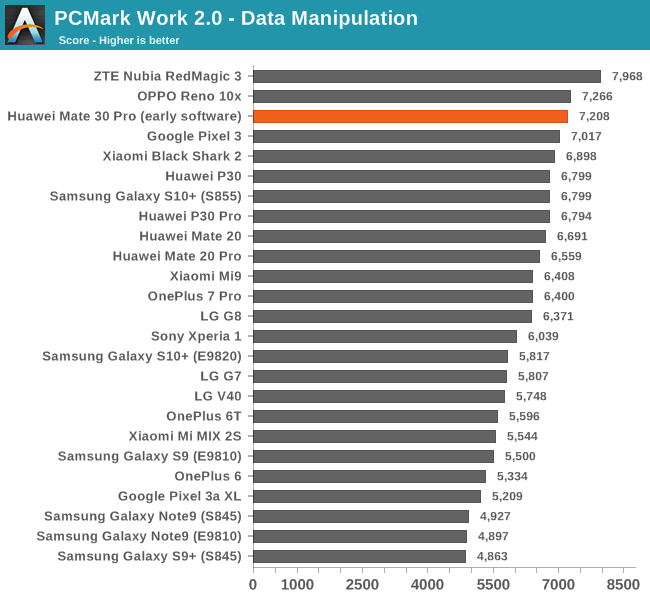A Day with the Huawei Mate 30 Pro: Kirin 990 and 7680 FPS Slow Motion Tests
by Dr. Ian Cutress on September 23, 2019 4:00 AM EST- Posted in
- Smartphones
- Huawei
- Kirin 990
- Mate 30 Pro
- 7680fps
A Benchmark or Two
Having had the smartphone for only a short while, I have not spent too much time on benchmarks – we will have that for the full review, when Andrei gets a chance to do a full teardown of the Kirin 990 SoC. For now, we have some PCMark data for you. The key test we like here is Writing, because this test is typically representative of a standard user experience and responsiveness.



With the extra CPU frequency and wider GPU, the Mate 30 Pro gets some gains over the previous generation Mate 20 Pro and P30 Pro, but ultimately nothing groundbreaking.
We attempted to run our AI benchmarks, however it would appear that Huawei is not yet ready with the NNAPI libraries for use with its Da Vinci NPU architecture. We expect those to roll out in due course.










47 Comments
View All Comments
zepi - Monday, September 23, 2019 - link
These high FPS modes are in the end just tools.Depending on the creativity of the videographer and the limitations imposed by the restrictions they can be useful or useless gimmicks.
Duration restrictions are quite severe, so it is not clear that these are actually usable for capturing interesting things. This is difficult to assess without actually trying and learning to use these tools.
Often times setup for such video captures is so time consuming and expensive, that it is impossible to create repeatable exercises to master such restricted tools...
Still, it is nice to see such features.
StevenD - Monday, September 23, 2019 - link
The ultra high FPS stuff is always a gimmick, I am much more pleased with the results of a good 240 fps than the impressive but short-lived 960.7680 is something else though. I can see it being useful filming explosions, but in that case, it's even harder to get the right shot, especially if you're using consumable materials, and the phone might not survive every time.
olde94 - Monday, September 23, 2019 - link
As a tinkerer (diy guy) and an engineer having a camera that can capture 125 micro seconds is really something useful, even with the limit as long as "getting it to capture the right time span" is not an issue. But for creative use i hardly see the use, but i might not be creative enoughmdrejhon - Tuesday, September 24, 2019 - link
The high speed features are not necessarily gimmicks for study purposes - for example, the analysis of displays benefits well from a true native 1000fps (and higher) high speed camera. High speed videos of display refresh cycles at http://www.blurbusters.com/scanout is one good example of high speed video becoming accessible to DIY researchers and student scientists who otherwise could not afford a high speed camera.alexvoda - Monday, September 23, 2019 - link
Just like removing the headphone jack (and not replacing it with another port) is stupid, removing the volume buttons is stupid.Something that before you could previously control just by using touch, now requires you to look at the phone.
I really wonder when we will outgrow this trend of removing physical controls in phones, cars and everything in between.
zepi - Monday, September 23, 2019 - link
Volume control is handled by the BT-headphones.close - Monday, September 23, 2019 - link
That's just one of the use cases. Turning the volume up or down for the ringer or any app streaming/casting to another device is another. And yes, you can always do it from software but it requires enough additional steps to make it annoying *every time* with no workaround.soliloquist - Monday, September 23, 2019 - link
Or when you are using the phone... you know, as a phone.I know no one does that anymore. But in that off chance that people want to actually talk to each other, being able to change the volume without moving the phone away from your ear/mouth is helpful.
not_anton - Sunday, September 29, 2019 - link
(AirPods user) Yea, sure...BedfordTim - Monday, September 23, 2019 - link
Especially when you have the phone in a case to protect the wrap around screen.